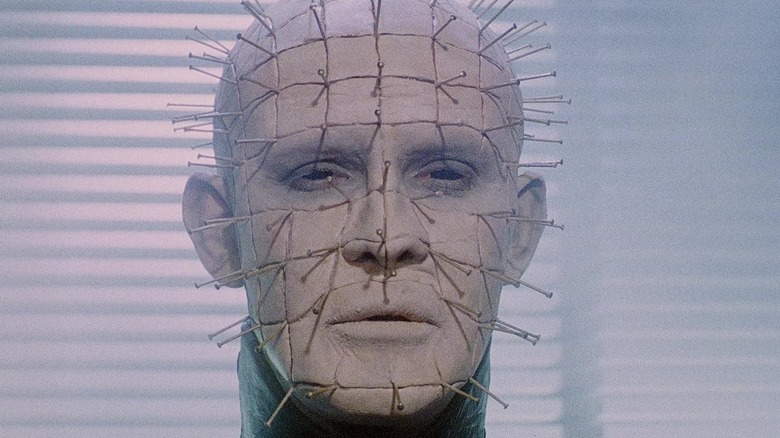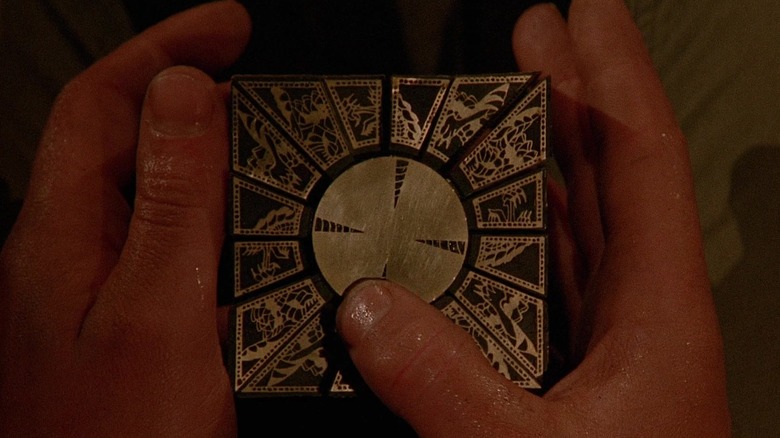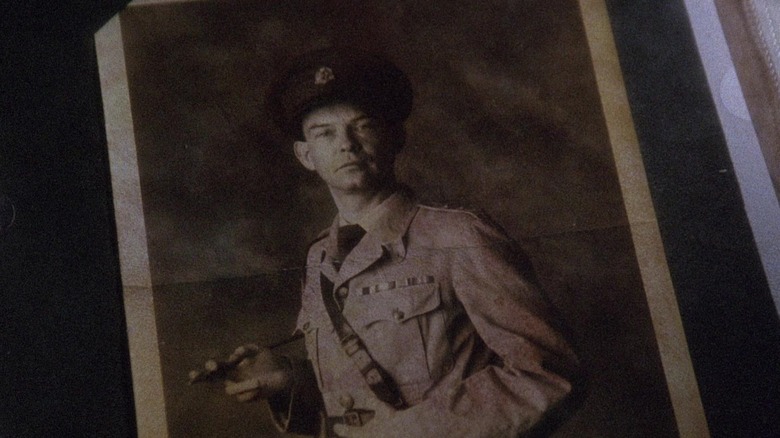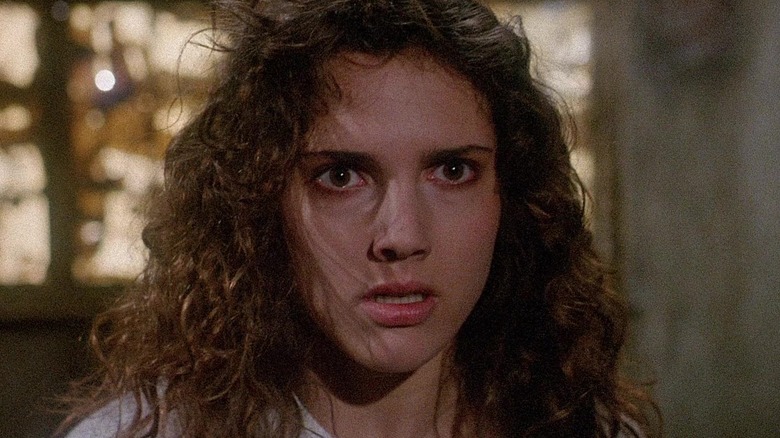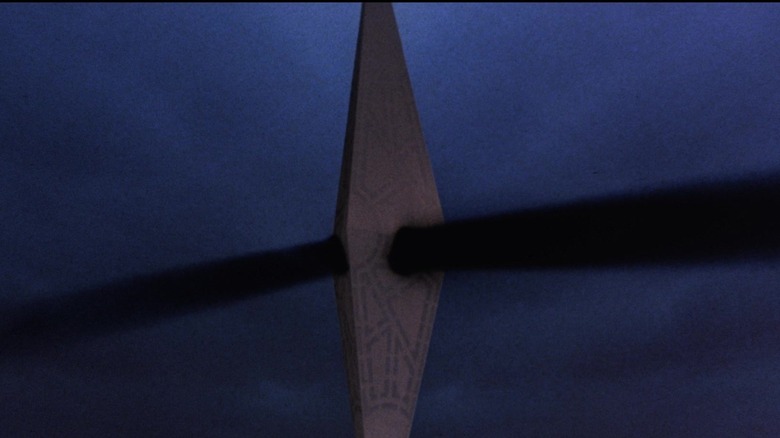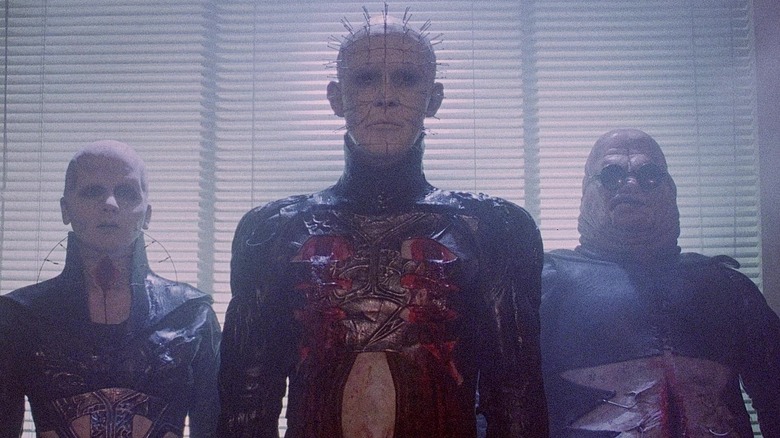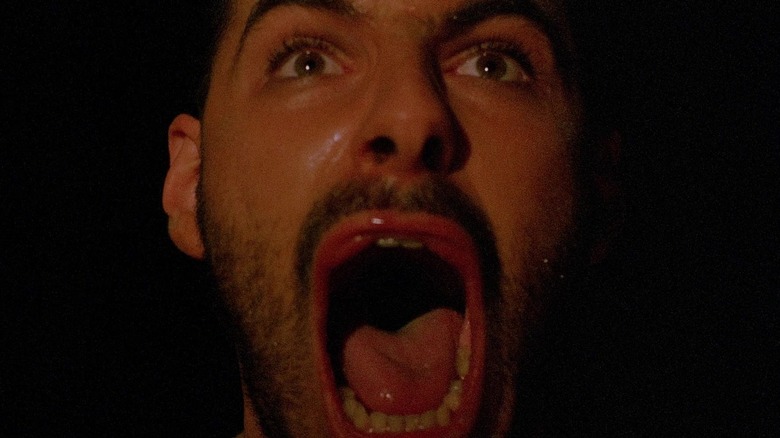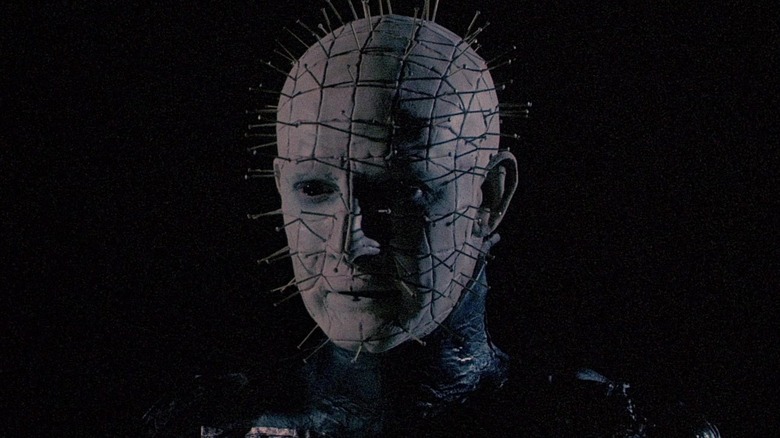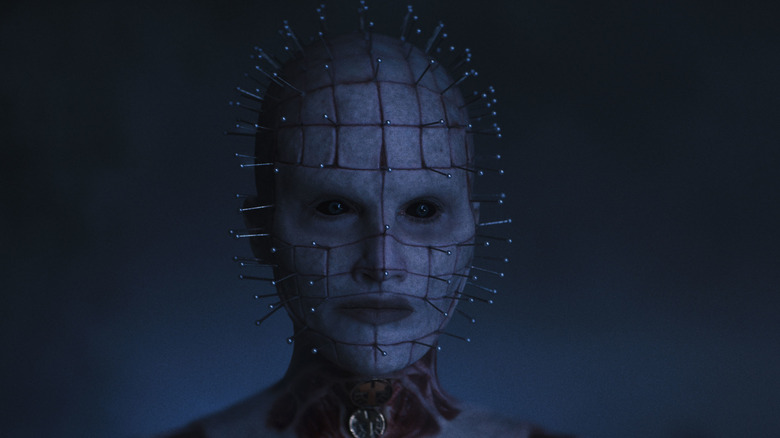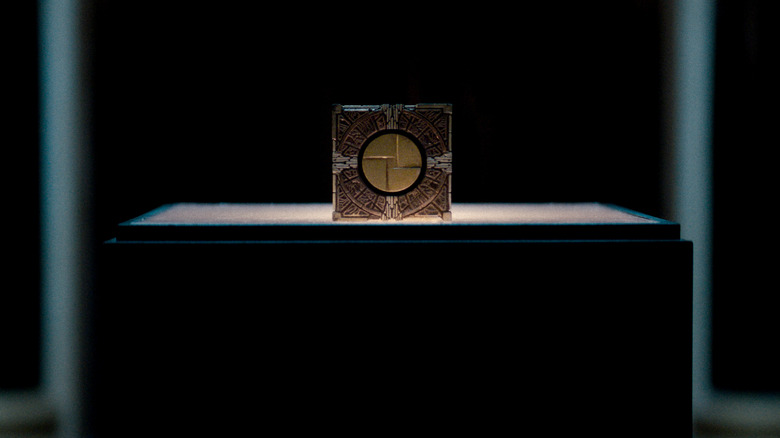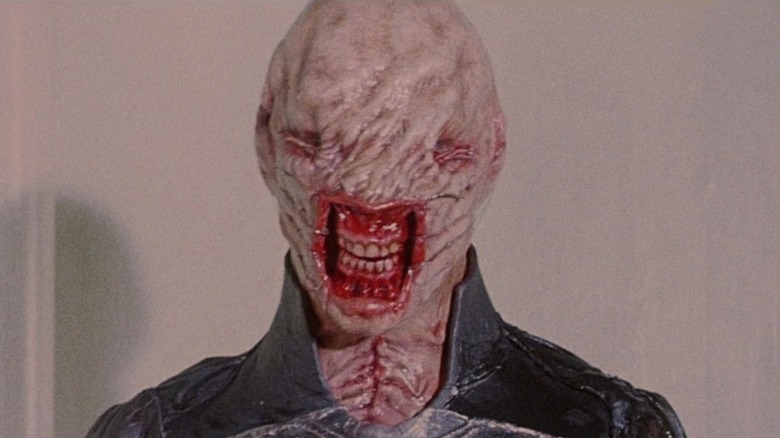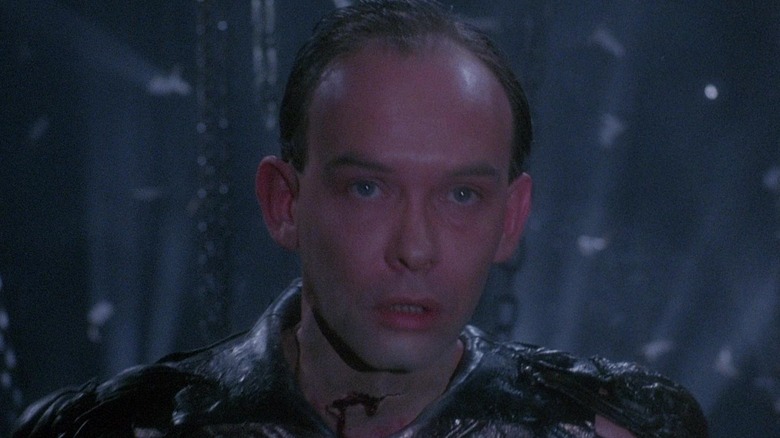Rules Pinhead And The Cenobites Have To Follow In Every Hellraiser
"Hellraiser" is one of the most iconic horror franchises of all time, bringing the terrifying interdimensional demon Pinhead to mainstream pop culture. This series has been around for quite a long time, since "The Hellbound Heart" was written in 1986 and the first film was released in 1987 — from that spark came a franchise with 10 movies spanning three decades. With the Hulu-produced "Hellraiser" and a possible HBO television series on the way, it's clear that the Cenobites are here to stay.
While not all of the "Hellraiser" films were considered successful (financially or commercially) they have succeeded in creating the lore and mythology of this sadomasochistic world. The original novella was written by legendary author Clive Barker as a reflection of his experiences as a hustler in the 1970s, as well as his experiences with S&M culture in his own life. In an interview with The Guardian, Barker said "It made me want to tell a story about good and evil in which sexuality was the connective tissue. Most English and American horror movies were not sexual, or coquettishly so – a bunch of teenagers having sex and then getting killed. Hellraiser, the story of a man driven to seek the ultimate sensual experience, has a much more twisted sense of sexuality."
With this philosophy in mind, Clive Barker would go on to write and direct the first "Hellraiser" film, and from there spawn a massive franchise with a mind of its own. With the new movie on the way, now is the perfect time to solve the puzzle box of "Hellraiser." Read on to find out the rules that bind Pinhead and the Cenobites in each of the "Hellraiser" films.
They Must Be Summoned By The Box
Cenobites are not your average, everyday demons. They are beings from another dimension that are only brought through schisms in reality created by LeMarchand Boxes. In the original "Hellraiser" film, the Cenobites are first summoned by the hedonistic Frank Cotton in his search for the most extreme physical sensations, opening a portal to their dimension. What he doesn't realize, however, is that Cenobites cannot distinguish pain from pleasure when they torture human beings.
While the details have changed throughout the franchise, what has remained consistent is the need for a puzzle box to bring the Cenobites into our reality. They are known as LeMarchand Boxes after their creator Philip LeMarchard, a French inventor from the 18th century who was obsessed with accessing Hell. In the lore of "Hellraiser," LeMarchand created multiple boxes that could be used to summon Cenobites, such as the Lament Configuration (which is the most iconic box seen in the franchise), The Triumph of Judas, Love's Easy Tears, and The Hollow Heart. Each box requires the user to push on a series of hidden pressure points to adjust the pieces in place before it opens up a portal for the Cenobites. There is some evidence, however, to suggest that the intention of the human using the box is more important than the object itself. In "Hellbound: Hellraiser 2," Pinhead himself says that "it is not hands that summon us, it is desire." Regardless, every single film in the "Hellraiser" series has featured a puzzle box in some form, making them the most trademark items in the franchise.
They Had To Be Human Once
Part of what makes the Cenobites so terrifying is the fact that they were once human like us, but have been transformed beyond recognition by their lust for pleasure and pain. With the exception of Angelique, a Cenobite introduced in "Hellraiser: Bloodline" who is the daughter of the evil god Leviathan, all the Cenobites in the series began as humans who were then converted through physical and psychological torture.
Pinhead, the most famous of the Cenobites and poster child of the franchise, has a more in-depth backstory than most. His time as a human is chronicled extensively starting in "Hellbound: Hellraiser 2," where we see that his human identity was a man named Elliot Spencer. Before seeking out the Lament Configuration, Spencer was a captain in the British Army during World War I. According to the movie, it was during the Battle of Flanders that the man who would become Pinhead lost all hope for humanity after witnessing the brutality of war. This would set him on a path of degradation that eventually caused him to be selected by Leviathan to become one of his disciples. Other popular Cenobites such as Butterball and Chatterer have similar human origins, although much less detailed.
They Can Only Torture People Who Summon Them
Although they are powerful beings from Hell, the Cenobites are bound to the rules of the boxes that summon them. They can't just teleport anywhere they want and start torturing people: They are bound to the specific individuals who solve the puzzle boxes (whether they do so intentionally or not). In the first "Hellraiser," both Frank Cotton and Kirsty Cotton summon the Cenobites by solving the Lambent Configuration. While Frank does this on purpose to experience the extremes of otherworldly pleasure, Kirsty does it completely by accident. Interestingly, the Cenobites don't seem to care why they are summoned, since Pinhead fully intends to capture Kirsty regardless of her knowledge of the puzzle box's purpose.
How and why Cenobites are summoned is important to understand, since the motivations behind their existence are complicated. There are two things that can happen when the Cenobites are bound to a human who brought them into our world: They are chosen to become a Cenobite themselves, or they are tortured for eternity in Hell. It all depends on who is worthy enough in the eyes of the Leviathan, the evil entity the Cenobites serve. So as long as you don't mess around with any strange ancient puzzle boxes, you should be safe from Pinhead and his friends.
They Must Serve Leviathan
As mentioned, the Cenobites do not act of their own accord, but instead serve a truly evil creature known as "The Leviathan," with titles like "Lord of the Labyrinth" and "God of Flesh, Hunger, and Desire." Similar to the Leviathan of biblical theology, this being is the ultimate antagonist of the "Hellraiser" franchise that all the Cenobites are created to serve. Since the series has been going on for so long, there is now extensive lore to explain Leviathan's background and motivations for torturing humanity. There can be no Cenobites without the Leviathan choosing, brainwashing, and molding them in its image.
While its exact creation is not explained, they do make it clear that the Leviathan hates the chaotic nature of flesh-bound mortals such as humans. Clive Barker designed a version of Hell that is distinct from all others, putting an emphasis on the distinction between pleasure and pain being less clear than we may think. It is a realm that exists on another plane of reality similar to the hellscape portrayed in films like "Event Horizon," where Hell can be accessed with technology. By portraying it as an interdimensional plane of pain, "Hellraiser" gives a suitably grand explanation for why these nightmarish creatures behave in such a horrifying way.
They Cannot Be Killed Easily
While this may not come as much of a shock, the Cenobites are notoriously hard to kill once they have been summoned. Since they wield the unholy power of Hell itself, it requires something of equal supernatural power to take them out. The films show that the Cenobites are resistant to traditional attacks or weapons, making them seem like immortal beings. Yet, there are times when Cenobites are actually killed in the series rather than simply being banished back to their dimension.
One way for Cenobites to be killed is if another Cenobite is the one attacking them. Based on the expanded universe of "Hellraiser," it is even suggested that regular weapons become more effective if a Cenobite is using them. In the 1993 comic "Clive Barker's Pinhead #1," the rebellious Cenobite Doomsayer is killed by another Cenobite named Atkins who wields a conventional assault rifle that he got from his human background as a Vietnam soldier. There is also the implication that Cenobites can die if they're reminded of their human past enough, which weakens them to attacks, as was the case when Pinhead was killed in "Hellbound: Hellraiser 2." When Kirsty showed him a photo of his old self, he became vulnerable and was killed by the newly-formed Cenobite of Dr. Channard. Cenobites can also be killed using special weapons with mystical properties, such as when Pinhead is destroyed a second time using a magically charged space station.
They Must Torture Their Victims
If there's one thing to understand about Cenobites, it's that they love pain. Whether they're receiving it themselves or inflicting it on others doesn't matter much. The pain they cause is deeply tied to their devotion to Leviathan and, furthermore, their own personal obsessions with sadomasochism. That is exactly why all Cenobites are tasked with the role of torturing their victims beyond recognition as a means of giving them the most extreme experiences possible.
According to the films, Cenobites seem to believe that there is a level of pain so intense that it becomes indistinguishable from pleasure, which is why people seek out the boxes in the first place. There is an implication in the films that the pain being inflicted upon the Cenobites' victims is somehow a good thing, and the creatures themselves no longer remember what it's like to feel fear of pain. As a result, Cenobites never show anything close to mercy, compassion, or regret in regard to their work. In "Hellraiser," Pinhead attempts to strike a deal with Kirsty to help them find Frank Cotton in exchange for letting her go. But this proves to be a trick as they intend to take her to Hell either way, showing just how far the Cenobites will go to torture humans.
They Always Have A Leader Like Pinhead
Throughout the series, the Cenobites are always led by an individual who shows stronger devotion and ambition than the rest. Usually, this role is filled by Pinhead, as he is the most recognizable character, but there is a surprising hierarchy within Hell that the "Hellraiser" franchise has created. Pinhead of the main series of films is referred to by many other names that reflect his station such as "Hell Priest," "Lead Cenobite," and even "The Pope of Hell."
He is the leader of his personal squadron (or "gash") of Cenobites, which he brings on his various missions to Earth. But he is not the only one to take charge, as there have been other Cenobites besides Pinhead who take on leadership roles in their torturing escapades. For example, there was a gang of rebellious Cenobites ruled by Alastor, who attempted to disobey their master in "Hellraiser Nightbreed: Jihad." In the newest film, "Hellraiser," a female-coded Cenobite named "The Priest" bears a striking resemblance to Pinhead and leads her own gash against Riley McKendry (played by Odessa A'zion).
Cenobites Transcend Gender
An interesting thing about the Cenobites of the "Hellraiser" films is that although they were once human, they seem to transcend the gender they identified with before their transformation. It is made clear throughout the series that once the Cenobites are transformed in the creation chamber they lose all knowledge of their past selves. The original novella clearly describes the Cenobites as being "sexless," or at the very least, ambiguous.
Cenobites tend to retain some elements of their human origins, and are sometimes even referred to by gender, such as the "Female Cenobite." Yet, the creatures themselves completely abandon any semblance of their old identities — the "Female Cenobite" began life as a sinful nun named Nikoletta. There are even more examples of Cenobites who are mutilated beyond recognition to the point that their previous identities are almost non-existent, such as "Butterball" and "Chatterer." In the newest "Hellraiser," the leading Cenobite resembles Pinhead but in a vaguely female form, showing how fluid the Cenobites can be.
They Can Be Banished Using Puzzle Box
Cenobites are hard to kill, but they are not as difficult to banish. As clearly shown in the first few "Hellraiser" movies, Cenobites are forced to abide by the same supernatural rules that bring them into our reality. Because of this, the puzzle boxes are the only thing that can save one of their victims. It makes sense that if the puzzle box acts as a gateway, it would function just as well as an exit from our dimension as it does an entrance.
In "Hellraiser," Kirsty Cotton saves herself from the remorseless Pinhead by grabbing the puzzle box and reversing its order. This puts all the pieces back into their original place, which sends the Cenobites back to Hell against their will. Another example of this working is in "Hellraiser 3: Hell on Earth" where the film's protagonist, Joey Summerskill, stabs Pinhead with the Lament Configuration in a way that returns him to his own dimension. While it definitely seems like it would be nearly impossible to survive an encounter with the Cenobites, it's good to know that there are some options for defending yourself by using their own rules against them.
Cenobites Are Always Mutilated
The defining physical feature of Cenobites in every single "Hellraiser" movie is that they're horribly mutilated and deformed. Part of the transformation process from human to Cenobite is that the forces of Hell torture, twist, and reshape their victims into beings of pure pain. This is why each Cenobite has unique features that distinguish them from one another, often related to some element of their past.
Pinhead is the most famous Cenobite for a reason, and that's because of his distinct look. Although Pinhead was not the character's original name (he's credited as "Lead Cenobite" in the first "Hellraiser"), the film's production crew lovingly referred to the character as "Pinhead," because of the hundreds of needles being driven into his head and face. Another example of this is with the "Chatterer," who has his entire face covered in burnt flesh except for his mouth, which is kept permanently open by painful hooks. The pain these creatures endure is essential to their characters, with each one being in a unique state of torment.
Cenobites Can Become Human Again After Death
Some of the lore surrounding the Cenobites is confusing, since the series has been around for so long, and there have been several movies with slightly different approaches to the monsters. One element that is consistent throughout the films is that Cenobites can actually transform back into their original human selves when they die. While it's not clear if this happens every time a Cenobite is killed, it has happened to the most important on-screen Cenobite of all: Pinhead.
The main instance of this happening is in "Hellbound: Hellraiser 2," when Kirsty forces Pinhead to look at a photo of himself as a man. This awakens something in Pinhead, bringing back his and the other Cenobites' repressed humanity for just long enough that they are open to attack. They are instantly killed, but death somehow reverts Pinhead back into the human body of his former self (Captain Elliot Spencer). Although this may have been a special circumstance for Pinhead and his goons, the more likely explanation is that Cenobites are very rarely killed, and as a result, their death in demonic form results in their human form returning in some capacity. Unfortunately, this is a part of the story only explored in the movies, and is not mentioned in the original novella.
